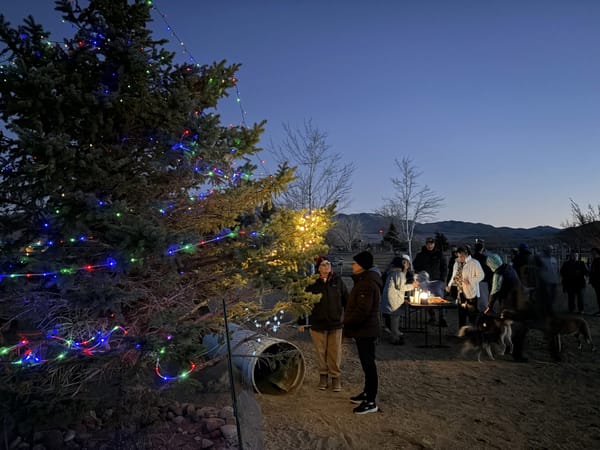King's Corner: Where Did They Go?
King's Corner column for the August 15, 2025 issue
So where did they all go?
The gold rush in California, followed by the silver rush in northern Nevada, brought a flood of people to our region during those boom years. An entire generation grew up mining the Sierra Nevadas and the Comstock. And then they were gone. Ever wonder where they went? The answer may surprise you.
At 13 yrs old my dad, ‘Mark’ King, helped deliver 80 head of cattle including 3 bulls for breeding from Yellowstone in Wyoming to Perth in Australia. This was 1939 and Australia was firmly part of the British Empire. Even now its official ruler is King Charles. Back then most immigration was from Britain and northern Europe. But when Mark arrived he met many people whose heritage was American, whose ancestors came generations earlier, many from Northern Nevada and San Francisco.
We think things change rapidly now, but a massive change came quickly to our region nearly two hundred years ago. In May 1847, when Mexico transferred California to the United States, the population of San Francisco was 459, most of them connected to the local mission named after St Francis. Eastward over the mountains, the area near Virginia City in Nevada had a single building in Gold Hill which, naturally, became a pub.
In January 1848 gold was discovered in California, and throughout 1849 over a thousand people a week arrived by sea to San Francisco. By 1859 the discovery of silver in the Comstock started a second wave, growing Virginia City from 4,000 in 1862 to over 15,000 the next year and over 25,000 over that decade. And at that time silver was considered the monetary equal of gold, so equally profitable to mine. And there was always a buyer, as all production was purchased by the federal government for use in coinage.
Suddenly the two largest cities west of the Mississippi river were Virginia City and San Francisco. In one recognition of this, Abraham Lincoln created the position of Secretary of the Nevada Territory. He appointed Orion Clemens to the role, who then moved to Virginia City with his brother Samuel, who began writing the colorful story of the west.
When everything’s new, creative and ambitious individuals can seize the opportunities. But after a while wealthy investors and companies begin to move in, and squeeze individuals out. Hydraulic mining started in California as early as 1853; Comstock mines began to be consolidated in the 1860s by “the Bank Crowd”. And it’s said that even in early days the companies providing the mining supplies – including tools and clothing – made more than the miners.
So if you’re an experienced miner looking for new opportunities, where do you go? How about the second biggest gold discovery in the world? In a place you could sail directly to from San Francisco?
Ever heard this part of the story?
In 1851 gold was discovered in the hills surrounding Melbourne, in what would become Australia. Between 1852 – 1860 seven times as many people rushed to these goldfields than came to California and Nevada. In those eight years 290,000 came from Britain, and the next largest group of 18,000 from the United States, almost all from San Francisco. Then in the following decade over one quarter of all migrants to the continent down under set sail from San Francisco harbor.
In one sense this wasn’t a surprise. Australia only existed because of America. Starting in the early 1700s Britain disposed of their convicts by sending them to North America. Then in 1776 the upstart colonists declared independence. Seven years later the British signed the Treaty of Paris, officially recognizing the fledgling United States. So where could they send their convicts now?
Britain chose Australia as the site for a new penal colony, and in 1787, the First Fleet of eleven convict ships set sail for Botany Bay, arriving in January 1788 to found Sydney, New South Wales, the first European settlement on the continent.
Which meant that many families now had misbehaving relatives scattered over America and Australia. That the same system of government that settled the thirteen colonies, which were now independent, had also settled the land down under. The language was familiar, the culture was familiar, and now they’d also discovered gold. And the thousands of sailing ships that had come to San Francisco and lingered in the harbor now had the new destination of Melbourne.
Sovereign Hill in the gold rush region there resembles Virginia City, preserved as it was in the 1870s. Both cities were built by many of the same people. Just as the Comstock includes Gold Hill and other nearby towns, that region down under includes Bendigo and Maldon with all their classic buildings. Just as Carson City grew nearby to be the administrative center, so did Melbourne. To visit here is to see the striking similarity in styles, in stories of the time, and in the surnames of those who were the early founders.
And who recorded these similarities? That young newspaper writer who became Mark Twain, in “The Wayward Tourist”, a fascinating, sometimes sad, but often very humorous excursion through Australia, its people, its cities and its peculiar histories.
I’m visiting family down under as I write this. Relatives here have the whole San Francisco side recorded, the American connection. I’m being reminded that all our stories have unexpected chapters, and may often come with surprise endings.

